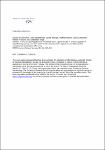Deletion of the rat cytomegalovirus immediate-early 1 gene results in a virus capable of establishing latency, but with lower levels of acute virus replication and latency that compromise reactivation efficiency
Sandford, Gordon R.
Schumacher, Uwe
Ettinger, Jakob
Brune, Wolfram
Hayward, Gary S.
Burns, William H.
Voigt, Sebastian
The immediate-early 1 (IE1) and IE2 proteins encoded by the major immediate-early (MIE) transcription unit of cytomegaloviruses are thought to play key roles in the switch between latent- and lytic-cycle infection. Whilst IE2 is essential for triggering the lytic cycle, the exact roles of IE1 have not been resolved. An MIE-exon 4-deleted rat cytomegalovirus (DeltaIE1) failed to synthesize the IE1 protein and did not disperse promyelocytic leukaemia bodies early post-infection, but was still capable of normal replication in fibroblast cell culture. However, DeltaIE1 had a diminished ability to infect salivary glands persistently in vivo and to reactivate from spleen explant cultures ex vivo. Quantification of viral genomes in spleens of infected animals revealed a reduced amount of DeltaIE1 virus produced during acute infection, suggesting a role for IE1 as a regulator in establishing a chronic or persistent infection, rather than in influencing the latency or reactivation processes more directly.
Dateien zu dieser Publikation
Keine Lizenzangabe
Verwandte Publikationen
Anzeige der Publikationen mit ähnlichem Titel, Autor, Urheber und Thema.
-
2000-10-01ZeitschriftenartikelLebensmittelassoziierte Virusinfektionen Höhne, Marina; Schreier, EckartBis in die 70er Jahre war die Diagnostik von infektiösen Diarrhöen auf den Nachweis von Bakterien und Parasiten beschränkt, und auslösende Erreger konnten nur in einigen Fällen ermittelt werden. Verbesserte Nachweismethoden ...
-
2015-06-19ZeitschriftenartikelIn Silico Prediction and Experimental Confirmation of HA Residues Conferring Enhanced Human Receptor Specificity of H5N1 Influenza A Viruses Schmier, Sonja; Mostafa, Ahmed; Haarmann, Thomas; Bannert, Norbert; Ziebuhr, John; Veljkovic, Veljko; Dietrich, Ursula; Pleschka, StephanNewly emerging influenza A viruses (IAV) pose a major threat to human health by causing seasonal epidemics and/or pandemics, the latter often facilitated by the lack of pre-existing immunity in the general population. Early ...
-
2015-11-10ZeitschriftenartikelComparison of the Cowpox Virus and Vaccinia Virus Mature Virion Proteome: Analysis of the Species- and Strain-Specific Proteome Döllinger, Jörg; Schaade, Lars; Nitsche, AndreasCowpox virus (CPXV) causes most zoonotic orthopoxvirus (OPV) infections in Europe and Northern as well as Central Asia. The virus has the broadest host range of OPV and is transmitted to humans from rodents and other wild ...

